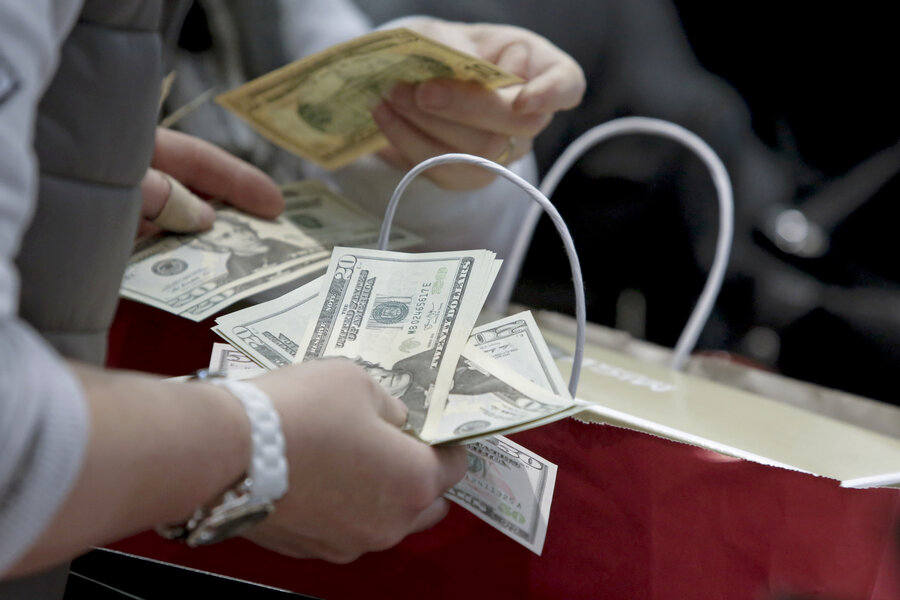You'll never shop alone again
Loading...
Ever feel like someone – or something – is watching you when you're shopping? You're probably right.
Increasingly, brick and mortar stores are tracking customers with apps and biometric technologies. They are logging information about purchases and building databases about consumer buying habits. And customers are typically clueless that they are being surveilled.
On the web, online stores are increasingly savvy about how to tailor ads for consumers based on preferences, webiste histories, and personal information. Much of this retail analysis is happening with a black box, closed not only to individuals but also federal regulators.
I recently spoke with Joseph Turow, Robert Lewis Shayon Professor of Communication at the Annenberg School for Communication, about his new book, "The aisles have eyes: How retailers track your shopping, strip your privacy, and define your power."
Edited excerpts follow.
Selinger: How are companies tracking us?
Turow: Most people know they’re creating a digital trail by using search engines, social media, and shopping online. But that only scratches of the surface of how companies can track us from morning to night.
Statistical analysis can link your different devices – what you do on your mobile phone, your tablet, and your computer – and that data can be integrated into customer dossiers. Companies also can use GPS technology to follow you outside and send you text messages containing coupons when you’re close to the stores they want you to shop in. And then, when you enter a store, companies can use their apps to follow you around. This way, they can send you customized messages about products and prices that are tailored to who you are and who they think you should be.
Selinger: Now that retailers and marketers have easy access to personal data that goes beyond age and income and includes information about behavior, lifestyle, and personality, what can they predict?
Turow: They mainly try to predict what you’d like to purchase and what your sweet spots are. That is, how much you’re willing to pay for a good or service and how long you’re willing to wait before making the purchase. They use that knowledge to incentivize you to buy their stuff instead of getting it from competitors.
Selinger: How does body language fit into the equation?
Turow: There’s a company in Russia that uses facial recognition technology to infer when people smile at the checkout. They use the information to select effective strategies for talking with customers and assessing whether customers had good shopping experiences. Other companies use body-recognition technology to infer a customer’s gender and age. Down the line, bodily analysis will become more pervasive and smarter.
Selinger: How much personal privacy can people protect simply by refusing to download store apps?
Turow: It’s complicated. People can ensure retailers don’t see them by not using frequent shopper cards, shutting their Wi-Fi off when they enter a store, shutting their Bluetooth off, and making sure all their apps are closed – not just sleeping. But going off the grid this way is difficult. For one thing, not using frequent shopper cards and apps often means paying a fair amount more. Also, people want to use a store’s Wi-Fi to compare prices with Amazon or other sites or apps. So going off the grid has real costs.
Selinger: How do retailers give people different prices in physical stores?
Turow: Stores do that by giving them discounts through their smartphones. Using Bluetooth beacons, for example, a store can track shoppers with apps that connect to Bluetooth devices placed around the stores. When pinged by particular devices, the phone can send a message to the store’s computer that tells it where a shopper is in the store – for example, in front of ladies shoes. Based on that and the profile the store has created about that shopper, the computer can send to the phone tailored messages and discounts for specific shoes – messages and discounts that others in the area might not get. Some people might get better discounts, others worse ones, and some none at all.
Selinger: Clearly, some forms of price discrimination are popular. I don’t think anyone is upset that senior citizens get discounted movie tickets. So, what’s the problem?
Turow: In the context of consumer surveillance, there are two interconnected problems. People are profiled without knowing how their files are created. And people are often in the dark regarding how personal information impacts what messages they receive, what they get charged and what quality of customer service they receive. Very few have a clue that prejudicial companies treat them differently from their neighbors. In fact, we have found in two national surveys that most Americans think charging different people different prices for the same goods at the same time is illegal.
Selinger: Should price discrimination laws change?
Turow: At the very least, transparent profiling should be a legal requirement. Transparency is one part of the larger concern I have about “information respect,” or what the Europeans call dignity. Changing prices for people based upon their clandestine profiles raises profound social questions. Do we want a society that has markets that pick winners and losers based on criteria people don’t know about and that they might not agree with?
In my book, I talk about how this seemingly distinctive 21st century activity hearkens back to an earlier era that took place before 1840 in the US and Europe. During this period, peddlers would show people different products based on what they thought they know about them, and change what they charged based on what they thought they could get away with and what they knew about the relationships customers have with other people.
This is a significant matter because consumer transactions make up a large part of public sphere interactions. I strongly believe markets shouldn’t operate in this way and that we are overdue for having public debate about the new retailing world we are entering.
Selinger: Are you saying that we’ve returned to something like the bartering of bazars without people realizing that they need bartering skills?
Turow: Yes, and there’s a stereotype that Americans don’t like to barter. Think of how clammy people get when they walk into car dealerships and worry that they’re not going to get a good deal. This attitude exists because for the most part we really haven’t had to think about variable pricing in quite a long time. Since 1890, prices are typically posted. The whole last century has been about what historian William Leach called “the democratization of desire” – the idea that everyone should be able to see what’s available for purchase and that all consumers should be able to see what everyone will pay before making any purchase.
In the world we are entering, the norm will be different: Stores might show people different goods, online and off, depending on how the stores have profiled and “scored” them. Additionally, people may be charged different prices – directly online and through discounts on smartphones – depending on those profiles and scores.
Selinger: Let’s end on an optimistic note. Right now, what can savvy consumers do to reclaim their power?
Joseph: Consumers can regain some leverage in different ways. Consider a simple implicit bargaining strategy that’s becoming popular. When you’re shopping online put the items you want to buy in the digital shopping cart, leave them there, and wait. If you wait long enough, a company might urge you to move things along by offering a discount on these goods.
At brick and mortar stores, your best bet is to compare the prices offered there to the ones available online. If they’re cheaper online, see if you can get someone from sales, or maybe just a cashier, to match the online price. Keep in mind, this strategy won’t be effective in the future if pricing software locates an equilibrium point and creates uniform pricing amongst competitors.






